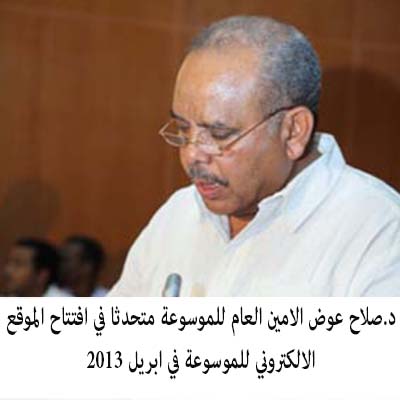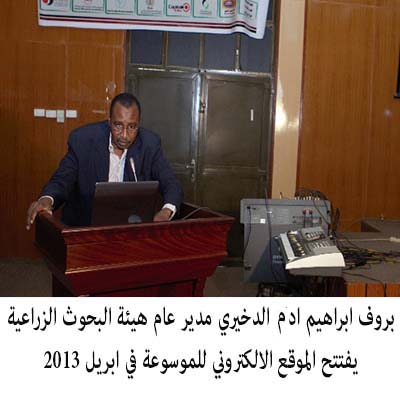البحوث
Pearl Millet ,Pennisetum glaucum, Production And Improvement In The Sudan By Elhag Hassan Abu-elgasim*
Introduction:
Pearl millet, Pennisetum glaucum (L.) R. Br,locally known as "Dukhun", is one of the important cereal crops of the Sudan, coming as the second most-important cereal crop, after sorghum , in both area and total production. It is the preferred staple food crop for the majority of the inhabitants of western Sudan (Kordofan and Darfur States). The average total area annually planted in the country is about 6 million feddans (2.5 million ha). About 95% of this area is found in Western Sudan.
The grain is consumed as human food mainly in the form of porridge, called "aseeda" or in the form of a thin pancake called "kisra". The stalks can be used as feed for animals but they are mostly used as building material or fuel.
Pearl Millet Production In The Sudan
Since pearl millet is a drought and heat tolerant crop capable of producing grain in regions of low soil fertility and limited moisture, where other summer cereals like sorghum and maize, may fail,it occupies the marginal low-rainfall areas of western sudan. This is mainly due to its extensive and more efficient root system, as well as its high ability to produce tillers. Although the crop is grown in areas where rainfall ranges between 200 mm to more than 1000 mm, most of it occurs in areas receiving 250-700 mm.
In Western Sudan Region, most of the pearl millet production is centered in the extensive sandy soils “Goz” occupying the northern parts of the region. These are marginal areas with less than 400mm rainfall. In these areas, pearl millet is the most extensively grown crop, and therefore, a millet-based farming system prevails. However, the cultivation of the crop extends further south into the clay soils where rainfall goes up to 700 mm. Within these southern areas, usually locations of lighter and more sandy soils are used for pearl millet. The average total pearl millet area annually planted in the sudan ranges from 5 to 7 million feddans (2.1 to 2.9 million ha). The crop is almost exclusively grown under rain-fed conditions,with about 98% of it being produced under traditional farming practices,mostly using local varieties.
Being an indigenous crop that has been growing for centuries in Western Sudan area, pearl millet has a wide diversity of local types. This diversity has been encouraged by the fact that pearl millet is a highly cross-pollinated crop (with 80% or more cross -pollination). Farmers continued to grow local varieties that are usually heterogeneous populations with broadly based genetic composition. Within the same farmer’s field, usually many different plant types can be seen. Inspite of this wiithin population variability, a number of local varieties or landraces could be identified and named by farmers in Western Sudan .The most widely known varieties include the following:
1- Dembi: This is the most popular and widely grown local variety in Kordofan. It has a light brown to yellowish brown seed color. It is comparatively late in maturity (around 120 days) with a medium or tall plant height.
2- Aish Bernu: Characterized by a slate grey seed color and a very compact head type that gives it some resistance to the attack of the head worm "Naffasha" (Heliocheilus albipunctella). The plant is usually tall and late in maturity. This variety is most probably a long time introduction from West Africa.
3- Hammer: Characterized by having deep yellow seeds with a reddish tinge. Its head is comparatively thick. Porridge ‘ Aseeda’ made out of it is yellow in color and is described as having a strong smell characteristic to millet. The variety was mostly in Hammer area (El Nuhud), but it is disappearing and now is mostly confined to El Magrur- El Odeya area in West Kordofan.
4- Sharoba: Has a creamy white seed color. It is widely grown in the western part of West Kordofan extending from El Nuhud to El Odeya and up to El Deaain in Darfour. It has similarity to the variety "Bauda" of Darfur States.
5- Bauda: This is the most popular local variety in Darfur State .It is characterized by having acream colored grain . It has heads of medium size and it is of medium to late maturity .
6- Abu Soof or Abu Shara: Refer to strains with bristled heads. They are usually mixed with other non-bristled strains.
Production Constraints
The grain yields obtained are very low, the average being less than 240 kg/ha.
Millet Production in the Sudan is being constaint by several factors including the following:
1.The millet is being grown in marginal areas with low rainfall .These areas are subject to large variation in rainfall in both rainfall amount and distribution throuth the years ,specially during the last three decades .This resulted in very low yields and variation in total production that resulted in large food gaps in the millet growing areas .
2.The varieties grown are mostly local varieties that are charectrized by late maturity and hence they can not cope with the current shortening of the rainy season which needs the growing of improved early maturing varieties.
3.The crop is mostly grown under traditional farming practices using local hand tools.There is a high need for developing optimum cultural practices for growing of the crop.
4.Since the crop does not enter the foreign trade and the country exports,it does not receive mush attention in terms of economic and political support .Hence, it faces a number of socio-economic constraints including lack of funding,agricultural extension
And provision of inputs.
Crop Improvement Efforts
The crop improvement efforts on pearl millet in the sudan ,has been summarized by Abuelgasim,(1989), Abuelgasim,(1992) and Abuelgasim,(1997).Inspite of the importance of the pearl millet crop in the sudan, it did not receive much attention to improve it prior to 1974 when a plant breeder was appointed for starting apearl millet improvement program in Western Sudan.The breeder was staioned at Elobeid in North Kordofan Province ,with the idea of initiating aresearh station there. He Started pearl millet breeding program by collection of the local millet germplasm from different millet growing areas in kordofan and some parts of Darfur regions .
The crop improvement program was initiated with the objectives of producing adapted improved varieties with high grain yield ,early maturity ,resistance to prevailing pests and diseases , in addition to having acceptable grain quality and taste.Improvement of the cultural practices was also taken in consideration .The millet improvement program was strengthed in 1977,by initation of a joint cooperative improvement program with the International Crop Research Institude for Semi –Arid Tropics (ICRISTAT), in india .A plant breeder from ICRISAT was stationed at Elobied to supervise ICRISAT millet breeding program.
This joint program resulted in the release of the first improved millet variety ,in ,January, 1981,under the name of 'Ugandi' This is an improved composite variety, with early maturity , bristled heads and grey seeds color.
The millet improvement program in the sudan, also received help from the international Sorghum and millet Improvemet program (INTSORMIL) of USA.The second improved millet variety, named 'Ashana',was released in the year 2000 . It is an introduction ,(SDMV 93032),from ICRISAT Millet program in Zimbabwi (SADIC program) .the variety 'Ashana' is characterized by early maturity ,resistance to downy mildew disease ,and it has grey grain color .
Presently ,the millet improvement program is continuing at three main research stations ,namely,Wad Medani, Elobied and Sennar stations.It has the same objectives as before ,and it depends mainly on local funding of research activities.
2.2.10. References:-
Abuelgasim, E.H. (1989) Millet breeding in the Sudan, past, present and
future.Proceedings of ARC/INTSORMIL Sorghum and Millet Workshop. October 28 - November 2, 1989, Wad Medani, Sudan.
Abuelgasim, E.H (1992). Pearl millet genetic resources in the Sudan. Workshop on
Crop Genetic Resources in the Sudan. Agricultural Research Corporation, Wad Medani, Sudan
Abulgasim, E.H. (1997) Pearl millet Research and production in the Sudan. A paper
presented in the scientific seminar of the Federal Ministry of Agriculture and Forests. Khartoum, Sudan. November 29, 1997. 9 pp (In Arabic).


